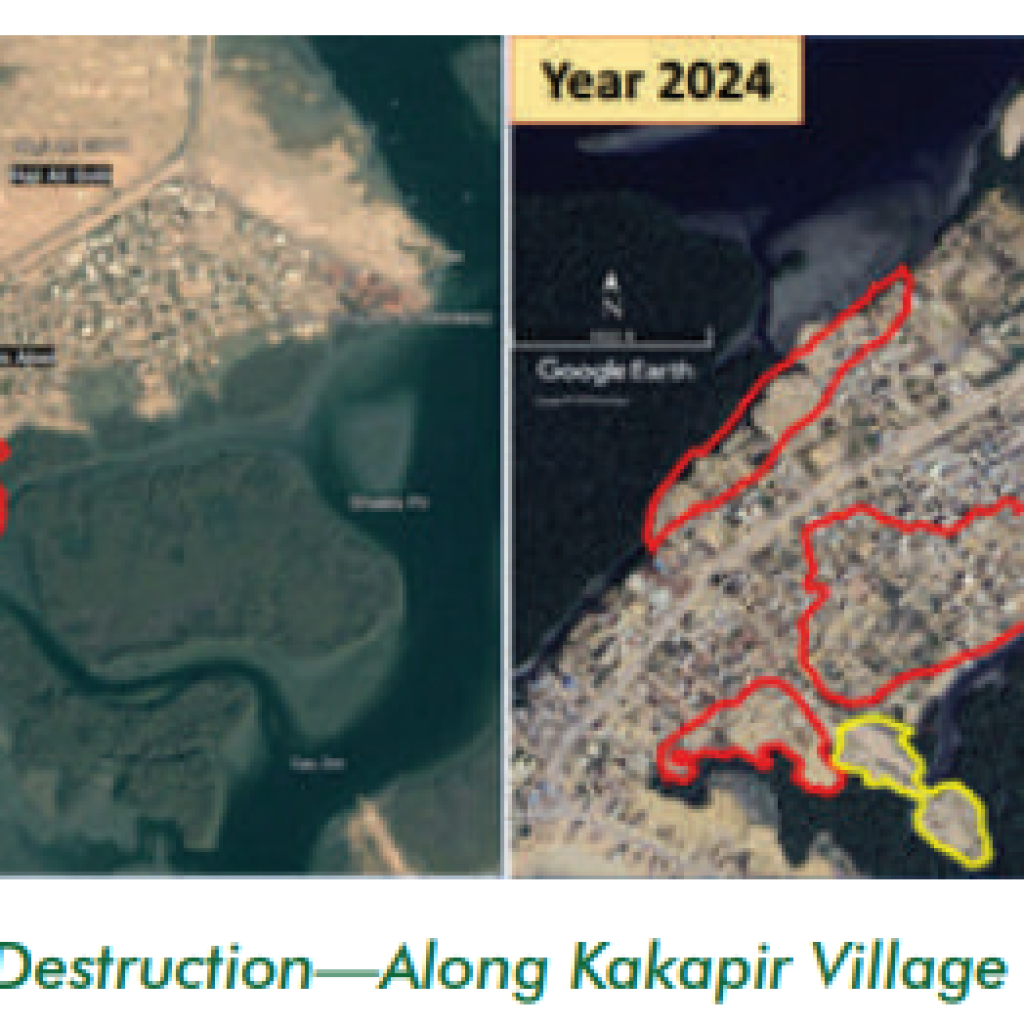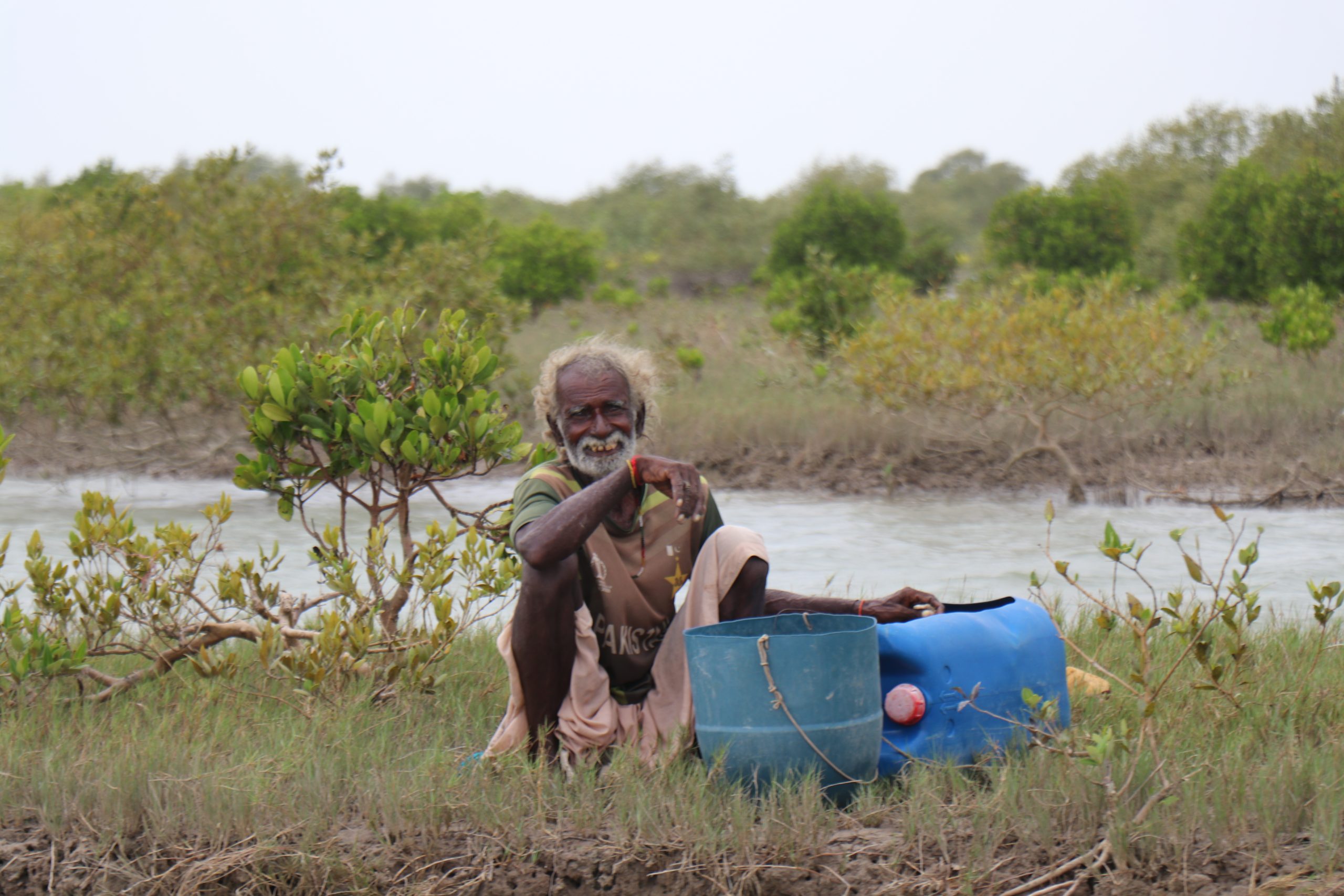It is said, “Money doesn’t grow on trees,” but in the Indus delta of Pakistan’s southern province of Sindh, mangroves are not only making millions of dollars but also providing hundreds of families with livelihood in a region where 80% of the population lives below the poverty line.
For almost a decade, 32-year-old Guddi Mallah, a resident of Gunb (Hassan Utradi)- has worked for the Sindh Forest Department. In her village, which comprises 26 households near Keti Bandar, a small seaport town in the Indus delta, she collects seeds, raises plantlets, and then rehomes/repositions them.
“All the men and women of my village do the same work,” says Guddi, as she relocates saplings before they take root.
In June and July, when there is a complete ban on fishing, all of Gunb’s families step into the mangrove forests and start collecting the shrubs’ seeds.
There are two periods of planting in a year: from February to May and from July to October. “We carry out plantations on thousands of hectares throughout the delta during these two seasons,” says Abdul Ghafoor, a forester at Keti Bandar, which is also a sub district of Thatta district. “Thousands of people are employed there”.
Increasing mangroves cover
Spread over 600,000 hectares, Indus delta is the fifth largest delta and seventh largest mangrove forest system globally, according to WWF. The largest chunk of these swamps about 97%are in Sindh, while the remaining 3% in the bordering western province of Balochistan.
According to The Global Mangroves Alliance’s (GMA) 2024 report, the entire mangrove forests in Pakistan are marked as “vulnerable”.
In the past, Pakistan’s former Climate Change and Environmental Coordination Minister Zahid Hamid has noted that the Indus Delta mangroves were “originally spread over 600,000 hectares [but] have been seriously degraded over the last 50 years as a result of hydrological changes, coastal developments, and pollution”.
However, in the Indus Delta region along the Arabian Sea, the cover has rapidly increased from 108,000 in 2008 to 250,000 in 2021, according to the Sindh Forest Department.“The mangrove cover in Sindh has expanded 300% due to continuous efforts by the Sindh Forest Department, federal government, the WWF, the World Bank, and other NGOs,” claims Shehzad Sadiq Gill, a divisional forest officer in Karachi.
Experts say 2010 and 2012 floods in Sindh — when about 55 MAF of water passed through the Kotri Barrage and went to sea — augmented mangrove forests. “Plantation was already underway and then came the floods, which gave life to those plants” says environmentalist Hammad Gillani, who also teaches at the National University of Science and Technology, Lahore.
Millions in carbon credits through mangroves
Although in the phase of recovery and rehabilitation at present, mangrove forests in Pakistan are, nonetheless, not only improving the environment but also earning money through carbon credits in the global market.
“The mangroves store four times more carbon than other trees,” says Gill. “That is why these are valuable in the international markets”.
Carbon credits were introduced as a concept in the 1997 Kyoto Protocol, which preceded the Paris Agreement. It is since then that a number of global treaties and country-specific laws have been introduced to fight increasing greenhouse gas emissions and, consequently, climate change and global warming.
One carbon credit is equivalent to one metric tonne of carbon dioxide equivalent (CO2e) that is reduced or removed from the atmosphere.
Then came into existence the carbon trading markets, where individuals, companies, and even countries can buy carbon credits to compensate for their greenhouse gas emissions.
These markets are of two types: voluntary and compliance. In many states, industries are obliged to offset their carbon footprints. For instance, if a facility is producing 10 units of carbon dioxide equivalent (CO2e), it has to purchase 10 units of carbon that is stored in forests. In the voluntary market, firms do that without any legal obligation but they get a monetary incentive.
The first time Sindh’s mangroves were monitored in 2021, it was revealed that they had the capacity to store 2.31 million tonnes of CO2e. “The carbon storage capacity of every plant, from one year to 25 years, is calculated and valued accordingly,” says Gill.
The average price per credit DBC-1 received is USD13.
To harness mangrove’s money-making potential, the Delta Blue Carbon (DBC) project was launched in 2015 as a public-private partnership between the Sindh government and Indus Delta Capital (previously Merlin’s Wood Private Limited). It aims to restore and conserve mangroves forests across 350,000 hectares of the Indus Delta and sell carbon credit generated through them.
On the International Day for the Conservation of the Mangrove Ecosystem, Maritime Affairs Minister Junaid Anwar Chaudhry claimed that the DBC project has sold CO2e credits worth USD40 million and is expected to yield billions in the coming decades.
As per the agreement between the Sindh Forest Department and Indus Delta Capital, the provincial government received 40%, while the private firm received 60% of the fund.
Lack of policy leave millions without basic rights
According to the United Nations Human Settlements Programme (UN-Habitat), Pakistan is one of the top five countries vulnerable to climate change. Though it produces less than 1% of the greenhouse gases, it frequently experiences floods, droughts, heatwaves, and other natural disasters.
“These mangroves forests can protect [the land and people] from cyclones,” says ecologist Rafiul Haq, who has also served at International Union for Conservation of Nature (IUCN). “Mangroves also provide sanctuary for fish, crabs, prawns, shrimps, and other species of fish.”
Haq is of the view that the socioeconomic conditions of the people living near mangroves have increased after the DBC project.
After restoring mangroves on thousands of acres successfully, the Sindh Forest Department launched another project, called the DBC-2, on a 225,000-hectare area three years ago. “If managed properly, we can build the capacity to store 200 million tonnes of CO2,” says Gill.
However, at present, Pakistan lacks a national carbon policy. In November 2024, the federal government issued its first national carbon marketing guidelines. “This is a new concept in Pakistan; therefore, preparing its rules and regulations take time,” explains Gill.
He said the federal government has issued the initial guidelines, but a national carbon policy has to be developed and a lot of other work remains to be done.
In the absence of a proper policy, most of the funds generated through the sale of carbon credits sit idle in the Sindh government’s bank accounts. As a result, people like Guddi Mallah continue to work on a daily wage of PKR 1,000 rupees (USD3.52 USD) and lack basic facilities.
In her village of 26 houses, there is no water, road, school, hospital or even electricity. The only government facility they have is a water connection that brings them fresh drinking water every fourth day.
According to the DBC-1 website, “Five RO [reverse osmosis] plants have been installed in different villages in the project areas and three medical facilities have been set up to provide local people with healthcare facilities. Also, it has created 21,000 jobs in Sindh.”
But Guddi Mallah is not happy. She complains, saying, “We need electricity or solar panels to light up our houses and run fans because there are too many mosquitos in the summer. Every year, a number of malaria cases are reported in our village and in its surroundings.”
Citizens lend a helping hand
According to the WWF 2024 report mangroves along the Karachi coast have faced continuous destruction due to residential, commercial, and industrial developments. It quoted the Sindh Forest Department as saying that nearly 200 hectares of mangroves have been lost between 2010 and 2022.

“Over 65% of the mangroves along the Karachi coastline are not under the control of the [Sindh] Forest Department,” says Haq.
Acknowledging Haq’s statement, Gill says Karachi is an expanding city, with a growing population and a high demand for fuel, which is why mangroves are being cut down. “We are aware of these activities and are trying our best to control these activities” he mentions.
The air is filled with the stench of sewer and filth. There are two boats carrying about 50 men, women, and kids — most of them students — ready to leave for Khadharo Island, an hour’s journey from Rehri Goth, a fishing village located at the bank of Indus River’s Korangi Creek.
“I will want a few minutes’ attention,” says Younis Khaskheli, a local climate activist in his 60s, as everyone settles in the boat. He tells them about the importance of mangrove forests for not only the fisherfolk but also for Karachi, a city of 20 million people that serves as Pakistan’s financial capital.
Every weekend, under his supervision, a boat or two leave for one of such islands, taking different people on a unique and purposeful trip where they not only enjoy the local seafood but also plant mangroves trees where land has been cleared of the mafias.
“Mangroves in Karachi’s surroundings are threatened by land and timber mafias,” says Khaskheli. “We can save these Islands by mangrove plantation.”
Mangroves need fresh water to survive
The delta is formed by rich sediment deposited by the river as it flows into the sea. “The Indus River was a perennial river before the building of dams and barrages started in 1932,” says Haq. “Now it has become seasonal (monsoon).”
According to the IUCN report, freshwater flow in the Indus used to bring 400 million tonnes of silt every year; however, in the past 60 years, it has decreased to 100 million tonnes.
“Mangroves need both saline and freshwater; the former to sustain and the latter to flourish,” says Gillani. “That is not discharged downstream as rulers think it is a waste of water.”
The 1991 Water Apportionment Accord in Pakistan says that at least 10 million acre feet worth of water needs to be discharged annually down the Kotri Barrage; however, the promise has never been fulfilled.
In a 2015 letter to then-prime minister Nawaz Sharif, a Senate standing committee wrote that sea intrusion along the coastal areas of Sindh could result in the sinking of both Badin and Thatta in a period of 30 years, followed by Karachi.
A 2025 study shows that 4.2 million acres of fertile land Thatta, Sujawal, and Badin have been lost to the sea and 1.2 million people have already been displaced.
Gillani believes that the biggest threat to the mangroves is sea intrusion, making not only the swamps but the local communities vulnerable too. “There is a lot of saline water in the Delta, but freshwater is not available, even for drinking” says Gillani.
“For the DBC project to thrive, we have recommended to the federal government a continuous discharge of water down the Kotri Barrage from the river or by building a reservoir,” says Gill.
As the Sindh Forest Department prepares to launch its third conservation initiative titled, “Carbon Removal through Public-Private Partnership Mode”, which is focused on restoring 40,000 hectares of riverine forest in Sindh’s Matiyari and Jamshoro districts, the UN has recognised “The Living Indus” initiative—launched by the Government of Pakistan and the UN itself in 2022—as one of its seven World Restoration Flagship programs.
The initiative aims to restore over 30% of the Indus River Basin by 2030.
“The Indus River is like a human body,” says Haq, adding, “If we are tending to its head, we can’t ignore its feet. Without it, the living Indus is incomplete.”
Header image by Manesh Kumar
Story produced with support from Internews’ Earth Journalism Network.


